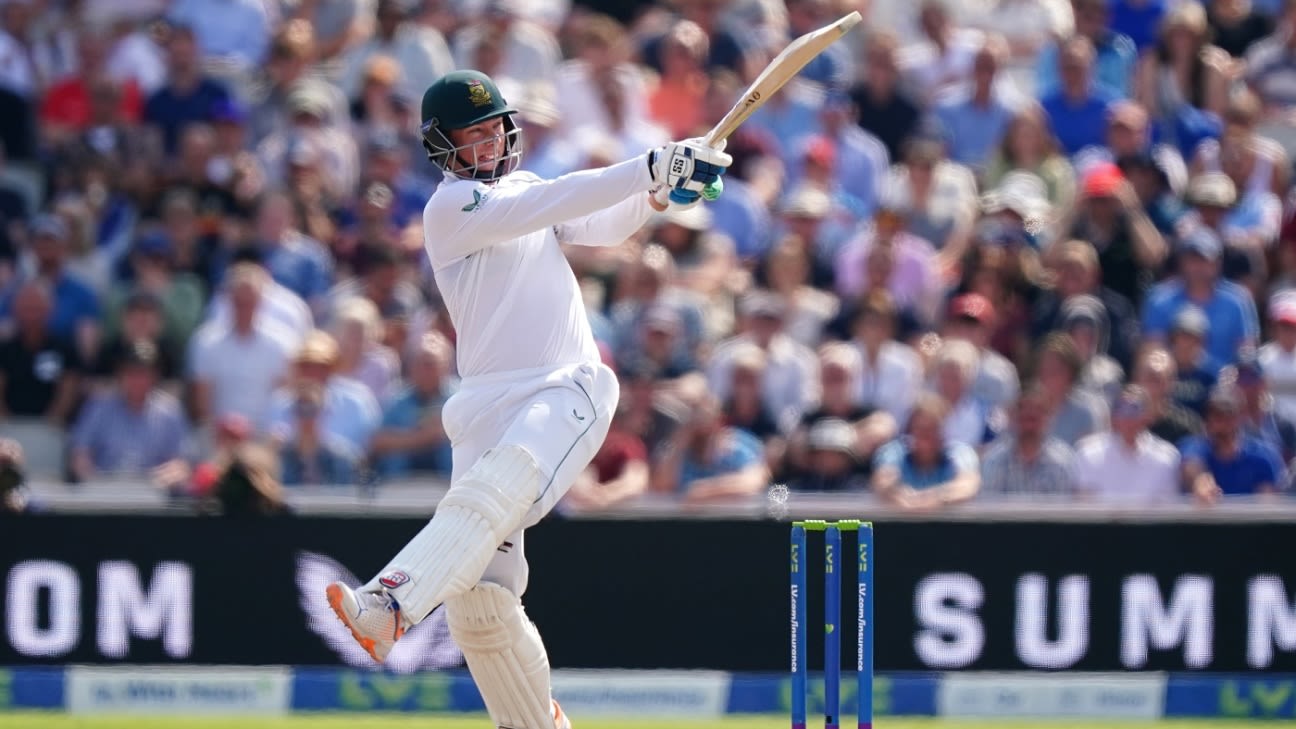Batting in Test cricket is not all fun and games, even if England are making it look that way. That's the word from returning South Africa batter
Rassie van der Dussen, who favours a balance of powers in the red-ball game rather than the run-dominant approach England have taken since Brendan McCullum and Ben Stokes took over in May.
In the Bazball era, England have scored runs quicker than anyone else,
at 4.77 to the over, and won seven of the eight Tests they have played. Their most recent
triumph over Pakistan in Rawalpindi was built on the back of four first-innings centuries, a brave second-innings declaration and speedy scoring - at 6.50 and 7.36 runs in the two innings - and is being spoken as a victory that could change the way Test cricket is played. But van der Dussen is not that convinced.
"If there's ever a place to play like that it's probably Pakistan," he said, quickly remembering that South Africa did not bat like that when they toured there in early 2021. "And then you are going to follow up with a question of why didn't we play like that when we were there. But if you look at the English side, they have been very vocal in terms of they are going to back their guys, even through a few failures. They are out of the World Test Championship (WTC) for this run so it's almost a nothing-to-lose type of game that they can play."
South Africa, on the other hand, are
second on the WTC points table and need to win at least one Test on the Australia tour to stay in the final race. While they plan on approaching the series in a similar way to how they have always played - steady with the bat and sensational with the ball - van der Dussen also hopes conditions will support a "good balance between bat and ball," something South have not had in the WTC cycle so far.
They have played on slow surfaces in the West Indies, and seamer-friendly pitches at home, in New Zealand and in England, where they suffered their only series loss. The 2-1 defeat is where van der Dussen believes his point was best proved: England's ultra-aggressive approach only works if the quick bowlers can't get into the game.
"To an extent, they [the England batters] tried it against us and it didn't really work, even though we lost the series at the end," he said. "That's an approach that can work if the conditions are really docile like it was in Pakistan. As soon as the bowlers are a bit more into it,
like we saw at Lord's, it's a very fine line between going out and playing aggressively and then getting out, as opposed to being more disciplined."
"People like seeing that - a lot of shots and a lot of runs - but the purist and the real Test fan likes it when the balance is even between bat and ball and the bowlers are in the game as much as the batters."
All that said, van der Dussen conceded that South Africa have not been the model line-up either. With only two centuries in their current WTC campaign and
six from their last 19 games, they are lagging behind the other WTC contenders and know that more is expected of them.
"We are not looking for excuses. We want to get more hundreds and more partnerships and score a lot more runs individually," he said. "But if we can bat as a unit, and get our team across the line, that's the main thing."
Scraping together small individual scores got South Africa a victory at Lord's but it quickly proved not enough. They were bowled out for under 200 in each of their next four innings in England, where all three Tests in England ended in three days. That spoke as much to the quality of and assistance for the bowlers, as to the weakness in both batting line-ups. There were only two centuries in the series and in the final Test at The Oval,
wickets fell every 4.2 overs - more frequently than ever before in a Test match. In the complete opposite to what took place in Pakistan earlier this week, bat dominated ball which is also not exactly what van der Dussen is advocating for. He punts for Test cricket that is "supposed to be a fair battle between bat and ball."
But what about the entertainment value?
McCullum and Stokes have taken the approach that more proactive batting will put bums on seats and eyeballs on screens. Asked if he thinks that is the case, van der Dussen stuck to his stoicism.
"I prefer the cat and mouse," he said. "We played against the England Lions in Kent and they played the same way. It was a very flat and tame wicket that they prepared and the guys came out swinging. At the end of the day, you say well played but this is not the Test wickets we are used to. A week later we were at Lord's and it was going around and the bowlers were much more in the game. That's where the real quality batters will come to the fore - the guys who are disciplined in that fourth-stump channel, who can judge the length, who can play the short ball - short ball that can actually come up to head height and not just shoulder height. There needs to be some sort of risk element involved in batting."
And he hopes fans will agree. "People like seeing that - a lot of shots and a lot of runs - but the purist and the real Test fan likes it when the balance is even between bat and ball and the bowlers are in the game as much as the batters."
















 Phone: (800) 737. 6040
Phone: (800) 737. 6040 Fax: (800) 825 5558
Fax: (800) 825 5558 Website:
Website:  Email:
Email: 






